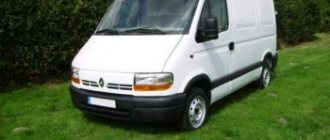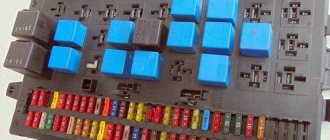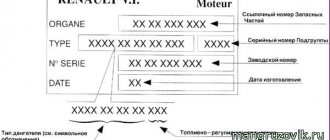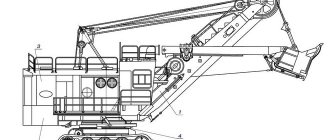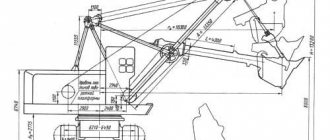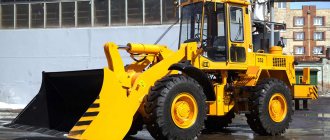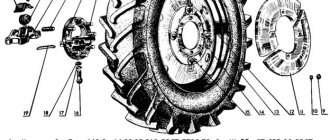These trucks are known for their original design and excellent technical characteristics. The truck belongs to the flagship model of the manufacturer Renault Trucks. Designed for long-distance transport. Once you see the Magnum, you will never confuse it with other truck models. The car has a cabin with a unique design. It is divided into two parts: in one of them there is a place for the driver and everything necessary to drive the car, and in the other there is a power unit and chassis.
Renault trucks are well known all over the world. I haven’t heard of them among truck drivers, unless you’re lazy. Stable, powerful, with an original design - this is how trucks of this brand, owned by the Renault Trucks concern, are perceived all over the world. The company is part of the Volvo Group, like Volvo and Mack Trucks. The combination of these three brands made it possible to create the largest French manufacturer. It is one of the most reputable automakers in the world. Renault trucks have been breaking all records for global sales for several years now.
Design
Since the 80s, the famous French company began to develop a new modification of the long-haul tractor, which was planned to become the best among the class. She became one. 1990 - presentation to the general public of a revolutionary configuration that received a unique name. No one had ever seen anything like this before. The design shocked the public so much that international carriers were initially skeptical about the truck. The car looked, according to entrepreneurs and logistics corporations, too “square.”
From the beginning of 1991, the Renault Magnum tractor went into production. Immediately after the start of production, the model becomes the “Best Truck”. This happens precisely because of its unique characteristics. It unexpectedly turned out to be highly effective, multifunctional, ultra-reliable, and acceptable in terms of price-quality ratio. The design has become familiar to everyone. Competitors did not expect rapid success from the modest French.
Truckers soon liked everything about the style of the new tractor:
- Square shapes;
- High-quality optics;
- Comfortable windshield, wide view of the road;
- Unique steps and handrails, unusual for freight transport of that time.
Generations Renault Magnum
The first generation of the mainline tractor was produced from the beginning of 1991 to the end of 1996. These machines were designated AE. The starting configuration of the cars accommodated 8-cylinder V-type power plants. They were designed for 16 liters. Similar engines were labeled Mack Truck. The engine output was 560 horsepower.
Carriers could purchase configurations with a 420-horsepower unit with a volume of 12 liters. These were already in-line engine options.
The second replaced the previous version of Magnum in '97. The new product received some modifications to the cabin, but the restyled modification did not receive critical distinctive characteristics. A significant change affected Mack engines, which had a V-shaped design. The most noticeable change was the radiator grille. The previous model placed the Renault emblem in the middle of the structure, and on the restyle the signature diamond moved to its upper part.
The third generation Renault Magnum has become more modern. Its official introduction was in 2001. The sample acquired a new appearance and improved engines. The French brand has always tried to create the most environmentally friendly car that will show moderate fuel consumption. Therefore, engineers created the E-tech power plant, equipped with 6 cylinders.
Based on customer choice and relative general market demand, the new car was equipped with three engine versions:
- 400 horsepower;
- 440 horses;
- 480 hp
Analyzing the secondary market, we can say that Renault Magnum modifications equipped with the last two variants of units have become more widespread. Both types, 440 and 480, turned out to be very reliable and not picky.
In design, the new 2001 model differed from the second generation - a new radiator grille, redesigned headlights.
The fourth came out at the beginning of 2005. The main improvements affected, for the most part, only the inside of the cabin. The designers have finalized many details. The most recognizable is the new steering wheel design.
A number of engines were also improved. Now the DXi 12 and DXi 13 units have replaced the previous installations. If the third generation of engines complied with the Euro-3 standard, now the engines are already marked Euro-4, Euro-5.
Four generations
- The first generation of Renault Magnum trucks is considered to be the Renault AE model. It was on this car that an unusual cabin consisting of two parts was first installed.
Renault Magnum 1992
- The second generation is a restyling of the previous version of Renault AE. Renault Magnum first appeared in 1997. It differed from its predecessor by an updated instrument panel and radiator grille. The truck also received a new line of six-cylinder engines.
Renault Magnum 1998
- The third generation appeared in 2001, then the car was modernized and received a new six-cylinder engine with 480, 440 and 400 horsepower. At this time, trucks of this brand began to be called Magnum 440, 400, 480, taking into account the power.
Renault Magnum 2002
- The fourth generation of trucks rolled off the assembly line in 2005 and is still in production today. The current generation of trucks has received 2 models of Renault DXi12 power units, the power of which is 480 and 440 horsepower.
Renault Magnum 2008
Renault Magnum cabin interior
The main task of the designers was to create a car that was as comfortable as possible for the driver. Therefore, engineers improved ergonomics, conveniently positioned all instruments and main scales. Everything should be placed in its place at the driver’s fingertips.
The first innovation that amazed the public was a completely flat floor. So that the driver and passenger can comfortably get into the cabin, the designers came up with a revolutionary step design.
In the first generation, the ceiling height from the floor was 1.87 meters. Later, engineers managed to increase it to 2.07 meters.
Recent generations have swivel seats. Also, all versions have quite spacious sleeping areas. True, even here many owners found flaws - the bed was too small.
Renault magnum: Characteristics, photo of the Renault Magnum tractor
DXi13 Maximum power: 368 kW (500 hp) at 1400 rpm. Maximum torque: 700 Nm (71 kgm) from 1200 at 1500 rpm. Diesel, 6 cylinders in line - high pressure injection (2000 bar) with 2nd generation unit injectors with electronic control system (EMS2) - 24 valves - camshaft at the front, distribution at the rear. Bore 131 mm - Stroke 158 mm - Displacement 12.8 liters. Turbocharged exhaust with wide flap. High performance oil filter with replaceable disposable cartridges. Engine lubrication system capacity: 36 liters (33 liters during maintenance). Direction of rotation (from the gearbox): counterclockwise. Cold start device. Electronic regulator of the retarder mode. Emission level according to EEC EURO-4 standards (2001/72b1). Electronically controlled fan. Coarse fuel filter with sump and drainage connection from the instrument panel. Electronically controlled SCR and AdBlue injection control system. Coolant: antifreeze - 40°C. Cooling system capacity: 44 liters. The vehicle noise level is less than or equal to 80 dB. Exhaust retarder. CLUTCH 430 GD 900 (430 MFZ for Optidriver) Single disc. Hydraulic drive with pneumatic control. Automatic wear compensation. GEARBOX ZF 16 S 2520 TO 16 synchronized forward and 2 reverse gears (16.41-1). Aluminum crankcase. Rear gearbox with pneumatic drive and pre-selection valve on the control lever. Switching according to the Super H scheme. Speed switching with SERVOSHIFT amplifier. Control via cable. Assistance in economical driving mode DMS (Driving Monitoring System). POWER TAKE-OFF No power take-off on the gearbox. RETALIER BRAKE Exhaust retarder with a power of 193 kW at 2300 rpm, controlled by an electric valve. OPTIBRAKE: Combination of exhaust retarder and valve compression brake, the braking system is linked to the service brake and is fully electronically controlled, power 300 kW at 2300 rpm (330 kW for DXi13 engine). REAR AXLE P 13170 2nd generation, single reduction. Main pair 10 x 37 (gear ratio 3.7). Cross-wheel differential lock. Clutch acceptable for speeds other than zero. Max load on the rear axle: 13,000 t. STEERING Steering box with built-in hydraulic booster with variable reduction ratio. FRONT AXLE Offset 160 mm. Max front axle load: 7,100 t. TIRES AND WHEELS G. 315/80 R 22.5 LHS/LHD. Steel wheels. Decorative caps for the front wheels. Spare wheel with jack, temporary mounting. SYSTEM Service brake: Electro-pneumatic braking system, with two independent flows, electronically controlled (EBS). Disc braking on all axles. Dehumidifier with APM (Air Product Management) cartridge. Two-cylinder air compressor 636 cm3 controlled. EBS: - Anti-lock wheel system (ABS). — Drag torque controle (Torque control while reversing). Control of differential characteristics at speeds <10 km/h. — Testing the traction force of the coupling. — Emergency braking assistance. — Brake efficiency alarm. — Coordination of the brake systems of the tractor and semi-trailer.. — Combined operation of retarders and service brakes — Wheel anti-skid system (ASR). — assistance when starting up a hill (Hill Start Aid). — Wear leveling of linings Brakes for semi-trailers: Air hoses, ISO connectors. Electrical connections EBS 7 connectors. Electrical connections for trailer 15 connectors. Accessory socket, 15 connectors, 2X7 connectors. Parking brake: Pneumatic control, fixed by a cylinder with a spring. Signal about the parking brake remaining engaged. Emergency brake: Reliability is ensured by the independence of the main flow circuits. Adjustment: Automatic compensation of brake lining wear. CAB EXTERIOR : Cabin made of steel sheet, treated by cataphoresis, with synthetic covering. Radiator grille, blown, with a metallized coating, made of composite material (SMC), having a V-shape. Aerodynamic spoiler with integrated windshield access step and fog lights. Handles for holding and a platform for access to the windshield. Tilting the cab with a hydraulic jack. Protection against water according to EEC standards. 2 rear view mirrors with heating and remote control. 2 heated rear view mirrors, with a wide viewing angle, on the driver and passenger side. Electric sunroof. The windshield and side windows are multi-layer tinted. Air intake at cabin roof level. 2 windshield wipers with built-in windshield washers. 2 speeds and intermittent mode. Access door for adding oil and washer fluid. Gasket for closing the rear bottom of the cabin INTERNAL : Internal height throughout the entire cabin is 1.87 m. Ease of movement in the cabin due to a completely flat floor. Transformable design of the “MULTIPASS” cabin, the ability to easily transform the internal space depending on the driver’s desire (driving, waiting, resting, eating, etc.): Refrigerated place for bottles. Cross shelf behind the driver and passenger seats. 2 lamps on a flexible base. 1 lamp for the couch. 2 lamps with variable lighting levels for the driver's seat. Rear pull-out table. Numerous storage areas: behind the driver, above the windshield, cubbyholes in the dashboard and doors, under the passenger seat, behind the seatback, under the headrest of the lower bench, next to the rear cross parcel shelf (with mirror), behind the headrest « vis a vis ", a niche on the right panel, a pocket on the driver's seat, a hanger behind the driver. Console for storing things that need to be close to the driver (places for bottles, cassettes, CDs...). The inner wall of the door has built-in storage spaces (places for bottles, documents) and an ergonomic armrest. 2 adjustable lights with changeable direction of action (Total power 92 W).CONFORT seat with seat belt, headrest and armrest.
Engine and gearbox
Since the most successful engines of the model turned out to be the units of the latest generation of the machine, it would be fair to consider them.
As soon as the company decided to move to a new level of environmental friendliness, engineers began developing a new motor. The result was the already mentioned DXi 12 variant. Its rated output ranged from 440 to 480 horsepower. The choice of the most optimal type of engine was justified by the performance characteristics of the Renault Magnum, as well as its configuration. If the car was planned to be used under conditions of increased loads, then the best option would be a 480-horsepower engine with a 6x4 wheel arrangement.
The improved engine model had the DXi 13 index. This installation could already boast the Euro-5 prefix. The power of the unit is from 500 to 520 horsepower.
As a rule, diesel consumption of the last two generations was 32-40 l/100 km. The indicator greatly depends on:
- mass of transported cargo;
- carrier's driving style.
Also, no one has canceled the specifics of the terrain.
Renault Magnum transmission
As standard, the car was equipped with a 12-speed automatic transmission. True, such a transmission was slightly inferior in efficiency to the mechanical model. Therefore, the latest versions of the truck could be equipped with a “mechanics”, which had 16 speeds.
Renault Magnum
A. Trokhachev, photo by the author
Sensation. With this word, in 1990, European media reports began on the appearance of the avant-garde Renault Magnum for its time. Now this car has survived three generation changes and has become a common sight even on the roads of Russia and the CIS countries. It is valued for its maximum level of comfort and high performance. And carriers call him nothing more than “the ideal trucker.” However, there are spots in the sun too...
THIRD GENERATION
The newest Magnum was released in 2005. By this time, the flagship of the French company had placed on the podium of the prestigious European “Truck of the Year” competition three times: winning in 1991, taking silver in 1998 and bronze in 2002. Everything speaks not only about the high appreciation of the model by its specialists, but also about recognition by professionals from different countries.
The model range includes truck tractors, chassis and flatbed vehicles with a 4x2 and 6x2 wheel arrangement with a gross weight from 18 to 26 tons. Magnum is available in 15 wheelbase options, from 3920 to 6820 mm, which makes it a universal “commercial”. True, in Russia the range of use of the flagship is quite narrow: it is mainly used as a truck tractor for long-haul transportation on international flights. And one of the most common modifications in the Russian Federation is Magnum 480.19.
In the third generation, the Magnum version with the new DXi 13 engine with a displacement of 12.8 liters and a power of 500 hp is attractive. It appeared on the market last fall and meets Euro 4/Euro 5 standards. The engine weighs 1,140 kg and is equipped with second-generation unit injectors with an injection pressure of 2,000 bar. Its torque peak of 2450 Nm occurs in a wide rev range of 1050–1400 rpm. The Optibrake+ engine brake also offers impressive performance, delivering 510 hp of braking power. However, Russian transport workers prefer to buy this version of the vehicle exclusively for international cargo transportation. In our country, the use of such technology is still considered an unjustified luxury.
MINUSES
Repairers and carriers unanimously claim that the Magnum is a less problematic car than its younger brother, the Premium. When using semi-synthetic motor oil, the maintenance interval in Russian conditions is half as long as in Europe and is 40 thousand km. If we take into account that the optimal vehicle load is about 120 thousand km, it turns out that Magnum must visit the service area at least three times a year. But, despite fewer problems, he still has them.
| The fuel filter often capitulates before being used in Russian conditions. They change them in pairs, and not only at each maintenance, but it is also recommended to replace them between maintenance services, with a mileage of 20 thousand km. Given the low quality of our diesel fuel, they cannot withstand longer |
Injector pumps in American Mack engines often become a headache for Russian carriers. This is especially acute when they fail somewhere far from busy highways. As a rule, there is no branded service nearby, and in order to fulfill the transportation conditions you have to look for a replacement vehicle. In such cases, you have to think about a tow truck as a second priority.
the injection pump remains operational for two years, and in rare cases lasts longer. Carriers have noticed this pattern: as soon as the maximum period of the vehicle’s factory warranty expires, the high-pressure fuel pump inevitably breaks down. You can blame the quality of domestic diesel fuel for this as much as you like, but it doesn’t make it any easier for transport workers.
Fuel injector nozzles make our drivers truly jealous of their European colleagues. If in the EU nozzles last for 5 years, then in Russia they have to be changed annually, and in some cases more than once. The cause of the problem is the low quality of diesel fuel, and primarily dirt and foreign mechanical particles.
| The power steering filter must be replaced by a new one no later than after 80 thousand km. In Russia it is changed at least once a year or at every second service (40+40 thousand km). Cannot be washed, extended or repaired |
Bending of pusher rods is a typical picture of operation during cold periods. The problem is especially acute when frosts occur below –20° C. In severe frosts, the camshaft pusher rods rot, usually one or two at a time. In 90% of cases this is due to the use of low-quality oil or its untimely replacement. Let me remind you: the recommended oil change and maintenance interval is 40 thousand km. And the way out of the situation is to replace the pusher rods.
In cold weather the breather freezes. As a rule, this occurs at high humidity and a steady decrease in ambient temperature to –25° C and below. But there are cases when the problem made itself felt under more favorable climatic conditions. The malfunction manifests itself very simply: the engine begins to drive oil through the filler neck.
Webasto heater tanks also cannot withstand the harsh Russian winters. The problem is that their bodies are made by casting. The nuts are soldered into plastic, which becomes brittle at low temperatures. Vibration causes the joints to burst, as they say, with all the ensuing consequences...
Individual pumps fail solely due to unsatisfactory fuel quality. New cars in Europe can be maintained for 4–5 years without any problems, but in the Russian Federation, there have been cases where these parts were changed twice a year on the same car. To increase their service life, it is recommended to use the Separ-2000 separator filter and refuel at proven gas stations.
| The main belt is changed every two years or after 200 thousand km, the rollers - depending on the condition. During the next maintenance check for integrity and absence of burrs and cracks. Particular attention should be paid to the belt on used cars |
The accelerator pedal needs to be replaced due to failure when exposed to moisture. The reason is design features. Because of them, water, melted snow, dirt, road reagents, and deicers get inside, onto the contacts, and the unit fails. It cannot be repaired and must be replaced with a new one.
The rear stabilizer is one of the most vulnerable suspension parts. It suffers especially quickly when operating equipment on roads with weak load-bearing surfaces and road surface defects. For example, in Chuvashia there are many roads on which the asphalt simply collapses, although, as a rule, there are no signs limiting the axle load in such areas. In Russian conditions, stabilizer bushings break after a maximum of 200 thousand km, or even much earlier. The solution to the problem is this: go to the service station and replace it, there is no other way out.
, the separator heating relay is located extremely poorly - it constantly rots out. To eliminate the causes of the malfunction, it should be placed in a place well protected from moisture. As the practice of transport companies has shown, no artisanal measures to protect relays from premature failure give the desired effect.
Uneven wear of the brake pads is expressed in their grinding at a certain angle. It is noted by carriers even from those companies where there are not one or two such vehicles, but dozens. At the same time, road trains make different trips according to geography, duration, load, and weather conditions. This may be caused by a caliper defect, the factory is working on it. But the pads last more than 200 thousand km, which is very good. At a company service, they are often recommended to be changed after 160 thousand km, which is not always justified by the realities of operation.
| The service life of the generator is comparable to the service life of the engine, but brushes need to be replaced every 250 thousand km or every 2 years. An alternative to a new one can be a refurbished generator, the price of which is about a third lower than the original one. |
The springs on the front axle brake pads are very weak. They take off in separate aircraft on almost every long-haul flight. In general, they often fly out - possibly due to high vibration loads. However, this problem is not unique to Russian transport companies. In the Republic of Belarus, for example, famous for its good highways, this problem also occurs. Well, where, pray tell, can one experience large vibrations on the M1 E30 Moscow-Brest highway, on the way from Minsk to the border with Poland?! And there’s nothing to say about Europe: they monitor the roads there - be healthy! And the problem is that you can’t buy these springs separately; they are supplied with the pads. In other words, you need to spend time and nerves searching for them.
Cabin rocking caused complaints from owners of first-generation cars, but it is also typical for more modern modifications. To eliminate the “floating” of the cabin, according to the operators, it is necessary to install a fourth cabin level valve to level the floor level. According to feedback from carriers, Renault Trucks agreed with their arguments and promised to eliminate this problem back in 2006.
Dirt accumulates on handrails in any weather, but especially in rainy and stormy weather. Aerodynamics are to blame for this. Perhaps deflectors should have been installed in the corners of the cabin for a more optimal distribution of air flow, but the designers seem to have come to terms with this shortcoming. And drivers are no strangers. They even composed a story about this: “How can you recognize a Renault Magnum driver in a crowd of colleagues? Hands are always dirty.”
| An air compressor lasts for 500–600 thousand km, after which it can begin to burn oil. There is a repair kit of gaskets, but its cost is comparable to the cost of the compressor assembly. The dryer filter is changed every 60 thousand km |
The right rear view mirror looks beautiful, but looking into it is not always pleasant: it gets dirty faster and more heavily than the left one. The inconvenience is that during rainfall you have to wipe it down at almost every stop.
PROS
The French truck certainly has more disadvantages than disadvantages. And it would be very difficult to list everything that is called by name. Therefore, we will focus only on the most significant ones that influence the commercial attractiveness of a car for Russian carriers and their colleagues from the CIS countries.
A comfortable cabin has been and remains one of the main trump cards of the French flagship. During the release of the first and second generation Magnum, it was the largest in its class. And on a third-generation car, in terms of useful volume, it is second only to the DAF XF105 cabin. Due to the flat floor area of 5 m2, ease of movement is ensured for the driver and his replacement. The ceiling height is 1.87 m, which allows you to stand without bending. And the thoughtful geometry and large glass area create a good overview. Conditions for driver rest are almost ideal.
Equipment. Unfortunately, for Russia there is no special budget version of the flagship of the French truck industry. But for the money, the optimal equipment remains affordable. International carriers, as a rule, prefer the Classic cabin with a suspended driver's seat, a rotating passenger seat and a stationary berth measuring 1900x700 mm. It has drawers under the bunk, a refrigerator, air conditioning, and electric windows. In short, everything you need is there.
| The injector pump (not to be confused with the individual fuel injector pump!) is sensitive to the quality of the fuel. In the Russian Federation, the service life is up to 200 thousand km, and from Europe cars come with a mileage of 500 thousand km, on which a factory-installed pump is installed |
More powerful engines than the Premium model make the Magnum even more attractive to haulers looking for maximum performance. A car imported from Europe with a mileage of 450–550 thousand km in Russian conditions will take care of at least the same amount without major repairs, and in some cases up to 1.2 million km. Thanks to their characteristics, powerful motors make it possible to create high commercial speeds for delivering goods over long distances. For example, the DXi 13 engine with an output of 500 horsepower delivers 90% of its maximum torque in less than two seconds! And the peak of 2450 Nm is achieved over a wide speed range - from 1050 to 1400 min-1.
Fuel consumption , although not always within the values declared by the manufacturer, is not as great as one might expect. In particular, according to the technical reference book “Trucks and buses. Consumption of fuel, oils and technical fluids" (Ranok publishing house, 2005) for the Magnum 390/400 18 t model it is 33–36.5 l/100 km, for Magnum 430/440 18 t – from 34 to 37 l, and for Magnum 480 – in the range of 36.5–41.9 l. But carriers have more correct information. In particular, for the version with a 440-horsepower engine, the average consumption is 26–32 l/100 km in spring-summer and 29–35 l/100 km in autumn-winter.
Gearboxes of models B9 and B18 are distinguished by good reliability and, if used correctly, do not create any problems. Based on data from transport companies, 16-speed manual gearboxes last 700-800 thousand km. The latest generation Optidriver+ robotic gearbox has not yet taken root in Russia, but this is obviously a matter of the future. Its advantages are obvious: it is 60 kg lighter than a manual transmission and provides 3 percent fuel savings.
| The king pin repair kit lasts for 3 years in Russian conditions. Its mileage is affected by the condition of the springs. The set is interchangeable with the Renault Premium repair kit of the same model years, and the price of both is almost the same (taking into account exchange rate differences) |
Bridges, according to factory settings, last up to 1.5 million km. Models 1345 and 1370 performed well in our conditions. Sometimes the gearboxes are changed, usually after a mileage of about 1 million km. This depends on operating conditions and driver experience. It happens that a Magnum mainline tractor is working in a quarry (in the Russian Federation), and the driver does not shift up or down at the right time. For reference: for the entire existence of the official dealer of Renault Trucks (since 1994, Selyatino, Moscow region), only 10 gearboxes have been replaced.
The cooling system pump, unlike some competitor models, remains operational for 6-7 years. There are not so many such durable parts in modern trucks, since the manufacturer puts a certain service life into each part and is not interested in it being too long. Basically, the impeller of the pump itself wears out. Its cost in Russia is 634 euros.
Disc brakes on all wheels ensure stable retention of the given direction of movement. They are characterized by quick maintenance and extended service life (service life increased by 20%). Their effectiveness has been confirmed by tests: thanks to the emergency brake booster, they provide a deceleration of 7 meters per second where the standard requires 5 m/s. The brakes have hill start assist, 5th generation EBS, ESP, ABS and ASR.
The mileage of Michelin tires on the front axle in Russian conditions is approximately 300–320 thousand km, on the rear axle – 360–400 thousand km. In other words, what the manufacturer guarantees, the machine takes care of. After welding, tires can last another 150-200 thousand km. True, along with French tires, carriers prefer to install Japanese Bridgestone, American Goodyear, and Slovenian Sawa. The German Continental is used less often, although it is held in high esteem.
| The release bearing does not break at a distance of 350-400 thousand km. In Russian conditions, it can withstand two clutch replacements (each after 200 thousand km). An earlier “resignation” may result from the driver’s illiterate actions. |
The hitch height on tractors can be varied due to four fifth-wheel mounting options and the use of low-profile tires. For the widest range, a 1250 mm high SSU is used, for new generation trailers – 1100 mm, for large volumes – 1040 mm and for towing mega-trailers – 950 mm.
Maintenance costs are minimized as much as possible. Thus, the service life of air cylinders has been increased to 120 thousand km. The axle pins on the new generation Magnum do not require additional maintenance due to more lubrication. The hinge joints of the front and rear suspension do not require maintenance.
WHAT YOU NEED TO KNOW
Running in the engine during the entire period (approximately 5 thousand km) should be carried out in a gentle manner, using full power only over short distances. Do not force the engine or force it to run at too low speeds. Carefully monitor the water level and oil temperature. The transported load during the break-in period can be exactly the same as during normal operation.
| With proper operation, the clutch disc is unlikely to need to be replaced earlier than after 200 thousand km. Usually it lasts in the Russian Federation for two years, after which it has to be replaced. In principle, the part is reliable and, if used skillfully, has absolutely no problems |
Starting the engine using an external source. In the event that it is not possible to start the engine using the car's batteries, you can use an external power source (power unit or cart with battery). To do this, you need to turn off the general switch of the electrical installation; connect the charger or charger cart, observing the polarity. Then, using the general switch, you need to turn on the electrical installation and turn on the starter. Then let the engine run for 5 minutes at 1300 rpm. Next, turn on the low beam headlights before restoring normal idle speed. In this mode, let the engine run for one minute. You can now disconnect the charger or cart by first disconnecting the negative terminal. Finally, you can turn off the headlights.
Pulling away. Always engage first gear and shift to the rest in sequentially increasing order. This will prevent premature clutch wear. Since the gearbox has synchronizers, when driving you should not make any shifts or double presses on the clutch pedal. Use super-slow (“creeping”) gear “C” when driving in particularly difficult conditions or sometimes when starting from a stop.
| The working clutch cylinder (PCU) does not cause problems during 6–7 years of operation. There is a repair kit, but practice shows that quite often it does not help, so it is better to change the entire part. Otherwise, the money may be wasted |
Start of movement in winter. Before moving away, you need to let the engine idle for a few seconds. This is necessary in order to stabilize the oil circulation in the lubrication system. It is useless to warm up the engine at idle for a long time; it is better to start slowly and drive in gear, even at low speed. The engine cannot be used at full power until the temperature rises to +80° C.
insulation materials, padded jackets, or cardboard plugs on the radiator grill of supercharged vehicles. Such devices interfere with the cooling of the turbocharger air, thereby reducing the efficiency and durability of the power unit.
In the summer, you need to check the fluid level in the batteries as often as possible. It is important not to overload the engine and change gears as often as necessary to maintain optimal performance. The cooling fins of the radiator should be cleaned periodically, because... insects, dust, etc. falling on them. obstruct air circulation. For cleaning, it is best to blow with compressed air from the rear.
In dusty atmospheres, it is recommended to constantly monitor the air cleaner warning light. Do not forget that filter clogging depends on engine speed, and not on the speed of the vehicle. Operation in mountainous conditions, for example, requires more frequent use of low gears and, accordingly, an increase in the number of revolutions per minute. Therefore, you should focus more on time than mileage.
| The turbine changes according to its condition, usually after 600–700 thousand km. Its longevity directly depends on the quality of the motor oil and diesel fuel used. If there is a large percentage of moisture in the diesel fuel, then the turbine may “fly” even after 200 thousand km |
In the mountains , every 1000 m of altitude above sea level, the power of engines with natural formation of an air mixture drops by approximately 10%, and of supercharged engines - by 5%. On the other hand, we should not forget that the boiling point of water decreases by 3.5 ° C every 1000 m.
Coasting is not encouraged. The gearbox is equipped with an oil pump that provides lubrication. Using the neutral position of the lever for coasting will quickly damage the gearbox. Never drive downhill with the gearbox in neutral.
The retarder is recommended for use when driving on rough terrain. You cannot use a retarder on a slippery road. You should always strive to select the gear that allows you to use the engine in optimal mode.
The exhaust retarder does not work at engine speeds above 900 rpm. To slow down the speed, you need to release the accelerator pedal and press the retarder drive. It should be pressed for as long as the retarder is active.
The “J” type engine brake comes into play when the exhaust retarder is engaged. It should be used at speeds up to 2100 min-1. At these speeds, its maximum efficiency is achieved and these speeds correspond to the maximum permissible operating mode.
| Caliper repair kit. There are 3 types of repair kits, but basically they change the kit with guides: in Russia - every 200 thousand km, in Europe - every 400-500 thousand km. In rare cases in the Russian Federation, this set lasts up to a mileage of 300 thousand km |
The cross-axle differential lock of the rear axle cannot be used in turns, on soils with good grip properties (asphalt, dry or rocky rocks), or in combination with anti-skid devices (chains, etc.). You cannot engage the differential lock if one of the drive wheels is slipping.
Entering a danger zone. Before entering a hazardous area (such as a refinery), turn off all electrical appliances using the main switch. This turns off all electrical circuits, but the engine continues to run. If the engine stalls, do not use the main switch or operate the starter. You should resort to towing. You can use the general switch immediately after leaving the danger zone.
Stop. Apply the parking brake and set the gearbox to neutral. Before turning off the engine, allow it to run at low speed for a while. To stop the engine, turn off the ignition. In case of prolonged parking, turn off the power supply circuit with the main switch. Never turn off electrical equipment with this switch while the engine is not already stopped, otherwise the alternator and electronic components of the vehicle may be damaged.
| Front brake pads last 160–170 thousand km in the Russian Federation, sometimes up to 200 thousand km. It is recommended to change not according to mileage, but according to condition. You shouldn’t be flattered by a non-original: it can withstand less than the factory kit |
The disabled vehicle must be towed using the tow bar provided in the road kit. Attached to the front cross member, it is designed for on-road towing under normal conditions. Towing a stuck vehicle whose drive wheels are slipping in loose or clayey soil must be carried out with precautions. The engine must remain running at all times while towing.
Generator. The voltage regulator can be built into the generator or external to it. When parked, the generator must not be energized (turn off the power to the entire electrical installation). Do not turn off the electrical installation while the engine is running. Beware of incorrect electrical connections. The engine must not be operated with the batteries disconnected or removed.
An overload of the electrical network that occurs when installing additional lamps and other electrical appliances with greater power than those provided by the manufacturer's standards can lead to battery discharge and serious disruptions in the operation of on-board electrical equipment. It entails the loss of the manufacturer's warranty.
Air conditioner. To avoid refrigerant leakage during long-term parking, it is recommended to operate the air conditioner at least once a week for 15 minutes. This recommendation mainly applies to the winter period, when the driver does not use air conditioning for a long time.
| The rear brake linings remain operational for a mileage of 250–260 thousand km. Drums must be cleaned every time they are replaced. Replacement of the drums themselves - depending on condition. Typically, drums are nursed with 3 sets of pads. |
The auxiliary heater should be turned off when approaching gas stations. When performing electric welding or electric soldering work on a car, be sure to disconnect the batteries, otherwise the on-board electrical equipment may be damaged. Stop the heater before turning off the main switch. The volume of the autonomous heater tank is 18.5 liters, autonomy is about 75 hours.
filter element should be changed during a warranty inspection and when draining the oil from the engine. The mileage between two consecutive filter replacements should not exceed 40 thousand km. With more frequent drains and complete oil changes, the filter can be changed less frequently, focusing on the general operating conditions of the vehicle. It is allowed to use only original filters with a filtering surface of 75 dm2 and a filtering capacity of 15 microns.
Diesel fuel. The maximum permissible sulfur content in diesel fuel is 0.3%. If it is greater, then the interval between two successive oil drains should be halved. It is best to change the fuel filter element when draining the oil from the engine, but the mileage between two filter changes should not exceed 40 thousand km.
| The fog lamp remains operational in Russian conditions for 5–6 years. Due to its low location relative to the road level, it suffers from rotting of the supply wiring. Another reason for premature replacement is broken glass. |
Central lubrication system. When replacing any component or element of the system (pump, distribution pipes, primary channel), as well as when there is insufficient amount of lubricant in the system, it is necessary to pump it. To do this, press the time relay button and keep it pressed for at least 10 seconds, after unscrewing the drain screw at the end of the primary circuit. The system emptying cycle automatically stops after 3 minutes 45 seconds. If necessary, it can be stopped manually by pressing the button again. However, the manufacturer does not recommend changing the primary setting, which is designed according to the needs of the lubricated units.
Turbocharger problems. Incorrect operation of the turbocharger is detected by insufficient engine power, abnormal noise and the presence of oil in the intake manifold. You should not perform any independent actions related to disassembling the turbocharger. The solution is to go to the nearest service station.
If the turbocharger is replaced, before installing the new unit, fresh oil must be added to the lubrication circuit through the opening of the inlet pipe. In this case, the rotor must be turned manually so as to ensure lubrication of the bearings and thrust bearing. After installation, run the engine for 30 seconds without increasing the crankshaft speed.
| The cabin lift pump rarely fails. It is recommended to add oil during operation. Usually the oil comes out through the tubes, but in small quantities. But in any case, this is an alarming symptom, and in fact - a signal of a possible breakdown |
The air filter is cleaned by blowing with compressed air or rinsing with hot water. The maximum compressed air pressure should not exceed 7 atmospheres. The nozzle should be kept at a minimum distance of 3 cm from the filter paper. The flow must be directed opposite to the direction of filtration. When washing, the filter element is immersed in an aqueous solution of a detergent for about 20 minutes. Then it is rinsed until completely clean water begins to drain from it. The maximum pressure of the water jet should be 3 atm. The filter must be dried in air or using a hair dryer with a blowing temperature no higher than +70° C. The use of compressed air or an electric lamp for drying is excluded.
Purge of the fuel system is necessary after a long period of inactivity, when completely changing the fuel in the tank, when washing or replacing filters, when dismantling or leaking a particular fitting.
ON THE HIGHWAY
In general, the vast majority of Russian transport workers have no serious comments on the Renault Magnum. And those truck drivers from Belarus and Ukraine with whom I had a chance to communicate did not express “categorical” complaints against him. In general, the car is good, and most importantly, it lives up to the hopes of road carriers. In the Republic of Belarus, for example, Magnum undergoes two maintenance and service costs are within 1000 euros. In Russia, a car under warranty usually undergoes three inspections, which is equivalent in cost to approximately 1,300 euros. For used cars purchased secondhand, this amount is often added to the price of original and non-original spare parts, which have to be replaced due to natural wear and tear or breakdown.
| The accelerator pedal fails due to a design feature: moisture gets inside the contacts (snow, dirt, road reagents, deicers). Moisture kills electrical equipment, and full restoration repairs are impossible. |
In a good fleet, a new Magnum can be used in 3 years, sometimes in 3.5–4 years. Much depends on the nature of the cargo, the volume of the trailer or semi-trailer, the cost of freight, the nature of the work - with the forwarder or the manufacturer directly, and a number of other factors. For quick payback, the monthly mileage should be at least 10-12 thousand km, and better yet, all 15 thousand km. Otherwise, this is not a business that an entrepreneur should bet on, because the freight must be at least 70 euro cents per kilometer. Calculations show that with an average monthly mileage of 15 thousand km, the tractor will be used in 36 months, and with a mileage of less than 12 thousand km - in 48 months.
By the way, the largest road carrier of the Republic of Belarus, the group, having once tried Renault Magnum in business, began to sell the existing MAZs on the vine. In 2000, Genty purchased the first 30 Magnum 430 Euro 2 units, and in the middle of last year, another 104 Magnum tractor units were deployed on routes, but with a 440 hp Mack engine. Euro 3 standard. By the way, over the 10 months of 2007, 15 new Renault Magnums were sold in Russia, 9 of which were with a 480-horsepower Euro 3 engine and 6 with a 500-horsepower Euro 4 engine. By the way, Renault is not the only foreign car in park of the Belarusian carrier. Along with French equipment, Swedish (Volvo FH, Scania R-series) and Belarusian-German (MAZ-MAN) equipment operates there. But every year there is more and more French...
Chassis
The steering, hydraulic system, and brakes of the model are similar to other representatives of famous brands. It is worth emphasizing only the presence of such systems:
- ABS;
- FULL EBS;
- ESP.
The suspension deserves special attention.
The front part of the Renault Magnum is secured with reliable parabolic springs. A configuration equipped with pneumatic cylinders is also possible. The rear suspension is a pneumatic mechanism controlled by the electronic ECS system.
Specifications
The Renault Magnum truck tractor, chassis and Renault Magnum flatbed truck have several different wheel designs. There are 15 different modifications of the wheelbase of the truck - from 3920 to 6820. The automatic twelve-speed gearbox is easy to use. Ride comfort is ensured by smooth gear shifting. If necessary, it is possible to use the Optifuel Infomax system, which will appeal even to experienced drivers who have high demands on fuel economy. It makes it possible to learn how to drive a car so that fuel consumption is as economical as possible. So, with its help you can observe the difference in fuel consumption in different driving styles.
| Wheel formula | 8x4, 6x2, 4x6 |
| Gross Truck Weight | 16-18 l |
| Fuel tank volume | 1455 l or 1225 l |
| Average fuel consumption | 30 l |
The rear suspension of the car is on pneumatics with electronic control ECS, the front suspension is on air springs and parabolic springs. EBS Full and directional stability control the disc brakes. The pressure in a car's tires can be checked using a special tire inflation sensor. Using the sensor, you can prevent accidents on the road.
Flaws
Entire legends began to circulate about the disadvantages of the car, like any other such popular car.
The first, most famous drawback is the rather strange suspension setup. More precisely, the car cabin moves too freely relative to the frame structure. Despite the presence of reliable mounting points, when cornering, the steering command was carried out first by the suspension, and then by the cabin.
The problem is noticeable on rough roads, where the Magnum driver and passenger begin to shake violently, compared to other tractors.
The next minus is poor interior heating. The first and third generations of the car were equipped with not the highest quality stoves. Carriers had to constantly use autonomy.
Owners also note among the disadvantages the inconvenience of the driver's seat. Long distances cause back pain for many drivers. Many owners had only one solution to the problem - buy a disassembled seat from another tractor.
Prices for Renault Magnum
The cost of the first two generations starts at 500,000 rubles. For that kind of money, however, the seller can slip in a copy of the worst quality.
Newer configurations cost from 1 to 2.5 million rubles. The more expensive the option, the longer it will work without problems.
The Renault Magnum model can be called the best aftermarket offer for your money. It is reliable, has a long service life, and consumes a moderate amount of fuel. And spare parts can be purchased in any city where there is a specialized store for cargo parts.
